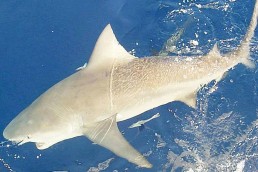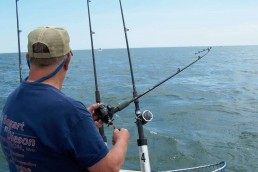More on the Great Lakes ‘Bloody Red’ Shrimp
SHARE THIS POST
The Bloody Red Shrimp
Further research on the Great Lakes’ newest imposters has brought forth a number of other details which may be of interest to anglers who fish the Great Lakes. Like all shrimp species, the bloody Red has a bit of color difference between its male and female gender. The female, as is common with all animal, bird and insect species on earth, tends to be drabber in color than the male. Males have the brighter, more gaudy and flashy coloring. Why is that Here is more on the Great Lakes ‘Bloody Red’ Shrimp.
Females of most species are drab in color for protection from predators while birds are nesting, while hiding with their young and while avoiding those who would feed on them when swimming beneath our waters. Males of a species are gaudy bright in color to attract females during the breeding season. The brighter colored the male, the more it may be that he is the strongest survivor of his species. Thus, he is the one to breed with for survival of the species. The brighter color he hosts, the better he is able to attract predators away from the female and his young. All species of shrimp carry similar features.
The female Great Lakes Bloody Red Shrimp is no different, though biologists have yet to study this invader closely. There definitely are two colorations in this shrimp. One, a polar-bear colored white with bits of silver brown streaks, is presumably the female; the other, a purer white with bits of metallic red streaks and a bit of brown on its thorax, presumably is the male. On the female, under her tail lie a series of tan eggs. Biologists tell me these eggs number from ten to eighty, and can be found 4 to 5 times a year. Like all shrimp, the Bloody Red invader does everything like shrimp species do throughout the world.
If you missed my first article on this Great Lakes invader, let me repeat some of its history. Originally, “Mr. Bloody” was discovered in the Caspian Sea in southwestern Europe. Then it transgressed and popped up in the Black Sea and on across Central Europe via their rivers and canal systems. Eventually, they overran England’s waterways where they became premier food for Atlantic salmon. Nobody knows how they got to the British Isles.
Fishing
In 2006, they popped up in Lake Ontario in North America. It’s surmised by most biologists that these hitchhikers had infiltrated the bilges of modern cargo freighters and that they’d been dumped into Lake Ontario and Lake Erie, transplanting the invader into its new homes in North America. Today, biologists have trapped this red devil as far west as some of the rivers along Lake Superior’s north shore. The Caspian Sea’s Bloody Red Shrimp is here to stay.
Anglers will have to get used to competing with the bloody one for your fish take. Steelhead love them. From this point on, I only surmise what has happened and will happen. Not being a biologist—just an old angler who has fished the world over and observed and learned from those experiences—I came to these conclusions. Biologists may or may not agree with me, as may you, my readers. That’s your prerogative!
I gathered as much information as I could from Roger Stack, owner of R & R Sports/ Fishin Hole on the south side of Milwaukee. Actually, it was Roger who brought the first mention of the Bloody Red Shrimp to me.
Roger’s clients have been purchasing thousands of an imitation freshwater shrimp which my small tackle company manufactures. These buyers are the steelheaders and spring coho anglers who know that steelhead (rainbow trout) and salmon (especially small coho) feed on the Bloody One.
Being a stream and channel migrator, I assume bottom-feeding rough fish such as carp and suckers enjoy this new food source. As a crustacean feeder, smallmouth bass will make my list of new food feeders as well. And there’s no doubt in my mind that Lake Erie’s walleyes will fill their stomachs with this fellow once this population of new shrimp is made available to them.
So far, the anglers who’ve been using freshwater shrimp imitations have been successful on catching steelhead and young coho via a number of presentation techniques. The first one is to cast your offering into deep water off the shoreline or rock jetties, allow it to reach bottom, and then use a quick snap-twitch as the lure is retrieved. Keep in mind, a shrimp has a jerky pulsating act to work its way across bottom while searching for food.
Are you enjoying this post?
You can be among the first to get the latest info on where to go, what to use and how to use it!
Those who’ve been most successful tell me this style of retrieve with the 1/8- and ¼-ounce imitators work best. Those using a smaller size, a 1/16-ounce, find these small ones work best beneath a slip bobber. Joe Radowski of Milwaukee finds the use of a 5 ½-inch “Bobber” Anne float loaded with a No. 7 and a No. 3 split shot pinched on 12 inches above the fake shrimp, then suspended 2 to 5 feet off bottom, works best for him. It seems the young Bloody Red Shrimp are found scattered at all levels of the water column.
As the photo indicates, there’s a possibility that this new shrimp can birth more than 80 embryos as biologists have indicated. These swarms of Red shrimp contain thousands of just-hatched young. It also shows the main color these young shrimp take on. As they grow more, natural colors are obtained. See the accompanying photos of the four stages of tied imitations.
Remember, I’m not a biologist. But I do learn a lot from you, my reader, as I take the time to listen and observe. Soon will be the time of year the Bloody Red one will be fed on by the fall run of steelies. The new Great Lakes Bloody Red imitations are in short supply. You’d better give Roger a call at R & R Sports and reserve a few.
The Bloody Red one is here to stay, like so many other invaders. We might as well get used to them and take advantage.
Keep in mind that the female loaded with eggs gives off an enticing scent and makes an excellent meal for gamefish. However, the male is easier to spot and he, too, is delicious to sportfish. I’m off to get in on the fall run!
A few last details…The Bloody Red Shrimp prefers shady areas such as under piers. Is a free swimmer avoiding direct sunlight. It has a lifespan of 9 to 10 months and breeds from April to October. They reach maturity at 5.6 mm of length and prefer water temps above 8 degrees Celsius (46 degrees Fahrenheit).
One negative factor they bring to our waterways is that they are harmful to the food base of small minnows, and maybe even harmful to the hatching fry of gamefish. That fact, good or bad, is still being studied by biologists.
Click to learn more about the Bloody Red Shrimp.
Become a MidWest Outdoors Insider here!
MWO
SHARE THIS POST
Did you enjoy this post?
You can be among the first to get the latest info on where to go, what to use and how to use it!
Dan Gapen
Considered one of the world’s leading river anglers, Dan Gapen, Sr. has shared his knowledge with MidWest Outdoors readers and viewers for more than 40 years. He is a member of all three Fishing Halls of Fame—International, National Freshwater, and Minnesota. He has an immense grasp of the world’s fisheries. He may be contacted at 877-623-2099.
@TheGapenCompany.



